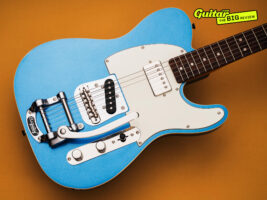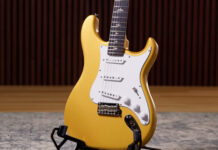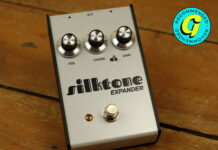
Squier Classic Vibe Custom Telecaster SH w/ Bigsby review – “this is a guitar that could take you places”
$499.99/£469.99, fender.com
I remember the first time I ever played a Squier guitar. I must have been 14 or 15 years old and the frontman of our band had just spent what at that time seemed an unbelievable amount of money on a classic butterscotch blackguard Squier Tele.
READ MORE: Gretsch CVT review: a cult classic reborn as a stripped-down rock machine
Up until this point, I’d been the big-spender of the band – having splashed the cash on an £80 Hohner Strat copy and a £30 Carlsbro keyboard amp from the local pawn shop – but to say this first encounter with a Fender-adjacent instrument was formative would be an understatement.
Here was an electric guitar that didn’t weigh so much that my shoulder ached after a few minutes of playing, that played like it actually wanted you to keep making music on it. That sounded, even through that godawful Carlsboro, like a real fucking guitar. Within a month the Hohner was back in a Cash Converters’ window along with my PS2 and I was the owner of a shiny new Squier Stratocaster.
All of which is to not simply fill up my intro with middle-aged reverie, but to remind us of the importance of Squier guitars to all of us. More affordable than Epiphones, their purpose as the first rung on what can be a life-altering ladder of guitar obsession for pretty much every guitar player I’ve ever met means that it remains, arguably, the most important part of Fender’s many-headed hydra of sub-brands and price brackets.
But if you’ve been paying attention to Squier over the last few years, you’ll have noticed something slightly unsettling. Yes, Squier still makes some scandalously affordable guitars – you can buy a Debut Series Strat for barely more than I spent on my Squier in 2004, and the genuinely great Sonic Series still cost under 200 bucks.
But at the other end there’s something of a bloat occurring – Squier guitars like the one we have on test here that scrape so close to the bottom end of the ‘Real Fender’ range you could stop for some lunch on the way home from the guitar shop and end up spending more than you would on something that says Fender on the headstock. But does this matter? Well, let’s find out…
Image: Adam Gasson
Squier Classic Vibe Custom Telecaster SH w/ Bigsby – what is it?
There’s an argument to be made that they must be charging by the letter at the top end of the Squier range – the callous disregard the brand shows for brevity in full display with this ‘Classic Vibe Custom Telecaster SH w/ Bigsby’.
Breaking it down, however, and we can of course learn a lot from this. The Classic Vibe range is one of those things you’ll hear guitarists conspiratorially whisper to one another down the pub – “I’ll tell you what…” they’ll say. “Those Squier Classic Vibes are serious guitars for the money… you could even argue they’re better than the cheapest Fender stuff…”
And broadly speaking, they’re not wrong. With more vintage-inspired aesthetics, better quality hardware and proper alnico pickups (as opposed to the ceramic ones in the cheaper guitars) the Classic Vibe range has become a quiet phenomenon. So good are these guitars that you’ll occasionally even see proper bands with record deals playing their trusty Classic Vibe guitars on stage.
And this Custom Telecaster really does emphasise the appeal of the CV range. If you put a bit of tape over that script logo, you really would have to be a proper nause to guess that this wasn’t a lovely old Fender from a distance – with its artfully tinted gloss neck and double-bound Lake Placid Blue body, it certainly looks the part. Even the laurel fingerboard here is a deep, chocolatey brown that would make you wonder if someone hadn’t put rosewood on here by mistake.
It’s all further enhanced by the added extras that differentiate this from the standard CV Custom Tele in the shape of the addition of a humbucker in the neck (borrowed from the limited edition 60s Custom SH) and now a licensed Bigsby B50 vibrato. It’s all quite a departure from that Squier Tele I played 20-something years ago… but at very nearly $500, it ought to be…
Image: Adam Gasson
Squier Classic Vibe Custom Telecaster SH w/ Bigsby – build quality and playability
The general level of fit and finish on the Classic Vibe series is a reason why the range has proved so popular with modders and upgraders – as a rule they provide an impressively solid base from which to work with, and so it is with this Custom Telecaster.
The finish is immaculately applied all over, with no cracks or overspray anywhere to be seen and clean, precise binding around both the top and back edges. The worry with any gloss neck is that it’s going to be a bit sticky, but in addition to looking handsome, Squier’s craftspeople have done a nice job in keeping it on the right side of ‘smooth without being tacky’ here.
It’s a pleasure to play, frankly – even if the 21-fret C-shaped neck is inevitably a little generic compared to some of the necks being produced by Fender in Mexico, for example. Generic doesn’t mean bad, however – it gets out of the way and does its job with aplomb.
The Bigsby vibrato is a temperamental beast at the best of times. It’s wonderfully musical and expressive tool, but the various points of friction inherent in the design, combined with the unreliability of the spring in terms of returning you to pitch consistently can make even USA-made examples somewhat eccentric when used with the lighter gauge strings most modern players prefer (rather than the telegraph wires the Bigsby was designed to work with in the 1950s).
That all tends to get magnified in the cheaper licensed Bigsbys you see on affordable guitars such as this, so it’s with a certain degree of trepidation that I approach the wobbly stuff here. Mercifully at least, the B50’s string-through design makes restringing much more straightforward than the classic method. Given that it’s likely to be many players’ first encounter with a Bigsby, it’s a smart move on Squier’s part to make this part less painful – it’s the sort of thing that can cause people to swear off a vibrato for life.
The vintage-style sealed gear tuners are solid and smooth, and that’s good because you’re definitely going to need them. That said, this is by far not the worst performance I’ve ever experienced from a Bigsby on a more budget guitar. I don’t doubt that the presence of the floating Mustang-style bridge is helping here – you can see it moving in concert with the bar and that certainly helps keep things more stable than it might be otherwise.
That said, it’s still not great – I wonder if the nut slots need to be lubricated or widened a little as they certainly look a little snug in places on my example. Such concerns are par for the course when it comes to owning a guitar with a Bigsby – just don’t expect Floyd Rose-level returning to pitch here and you probably won’t be disappointed.
One other thing to note on the build and playability stakes is the weight – this guitar tips the scales at a not-unreasonable 8lbs and 1oz. Now, the Bigsby is a big ol’ chunk of metal and adds a fair amount of mass to the guitar, so the poplar body has been routed internally to remove some of that weight – how that works out in terms of sound we’ll find out in a minute…
Image: Adam Gasson
Squier Classic Vibe Custom Telecaster SH w/ Bigsby – sounds
The danger when you start hacking chunks out of a solidbody guitar to make it weigh less is, of course, that it starts to behave not at all like a solidbody guitar when it’s plugged in. While this Telecaster is nowhere near as feisty and temperamental as a proper semi-hollow, running it into a cranked Princeton with a Chase Bliss Brothers in front of it does showcase a bit of unruliness that you wouldn’t expect from a Telecaster. Every knock on the body or clunk of the selector switch is audible through the amp and not exactly pleasant if you’re trying to record the damn thing.
There’s definitely a bit of that liveliness on the bridge pickup with this configuration too. It’s brash, and a little on the cutting side – I was instantly reaching for the tone control to tame some of this bratty excess, but if you like your Tele bridge pickup to cut through, you’ll have no real complaints here.
Conversely, the neck pickup is a much darker and more woolly affair – if you want some classic sustain-heavy leads it’s great, but things get quite messy when you add chords to the mix.
The middle position is often the poor relation of many a guitar configuration, but here it actually splits the difference between the two – taking the depth and warmth of the neck and blending it with the clarity and punch of the bridge to create something that’s balanced and rather lovely.
Step off the gain, however and all three selections make a lot more sense – you can get fiery with the chicken picking with the bridge, while adding some delay and reverb to the neck pickup is a warm, comforting bath of a sound. It’s very nice indeed – especially when you introduce the hazy wobble of that Bigsby.
Image: Adam Gasson
Squier Classic Vibe Custom Telecaster SH w/ Bigsby – should I buy one?
There’s no escaping that Fender is really pushing the boundaries of Squier’s credibility with the pricetag of these top-end Classic Vibe instruments. For another hundred bucks you can get yourself a Standard Series Telecaster with Fender on the headstock, after all.
But the thing is, this is a demonstrably superior guitar to the Standard series in every meaningful way, bar that headstock decal – it certainly looks better in every meaningful way, and I’d say the sounds are better too, thanks to the presence of proper alnico magnets in the pickups here.
However, $500 is still a lot of money for a Squier guitar, and it’s complicated by the fact that it’s not as well sorted as it perhaps could be – the Bigsby is still a temperamental beast and the pickups are definitely in the ‘good but not great’ category – something that’s probably been accentuated by the weight-relieving body routing making it feel a bit like a rollercoaster straining to keep on the rails at times.
But here in 2025, where $500 is roughly half the cost of a flagship mobile phone and a trip to the cinema will leave you needing to take out a personal loan, this is an awful lot of guitar for the money. It’s a guitar that could take you places, and it won’t let you down on the way.
Squier Classic Vibe Custom Telecaster SH w/ Bigsby – alternatives
Would you believe that there are no other Telecasters in Fender’s current line-up that offer both a Bigsby and a HS configuration? If you can live without the Bigsby, however, there are some interesting options – the regular Squier Classic Vibe Telecaster Custom 70s ($449.99/£385) takes things in a more 70s direction visually, while the Fender Player II Modified SH ($1,079.99/£999) offers an upgraded take on the format with Noiseless pickups and other player-friendly additions. If you want something outside of the Fender stable that keeps a lot of the vibe, the Schecter PT Fastback II B ($849) offers a pair of humbuckers to go with the Bigsby B50.
The post Squier Classic Vibe Custom Telecaster SH w/ Bigsby review – “this is a guitar that could take you places” appeared first on Guitar.com | All Things Guitar.
Source: www.guitar-bass.net











